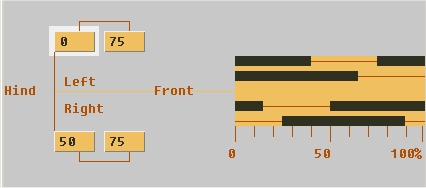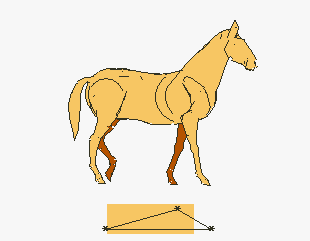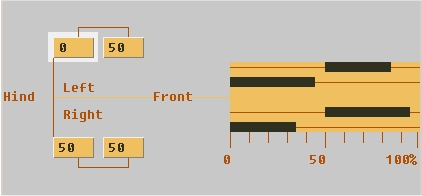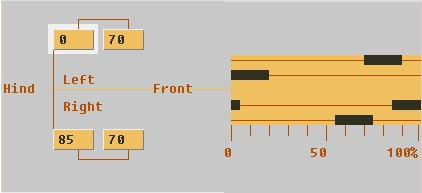Quadrupeds


|
Horse in a walk
Horses are perfectly suited to demonstrate four-legged gaits. The 19th century photographs of Eadweard Muybridge were used as the source material for these animations. In the walk, the footfalls are evenly spaced over a cycle, so there is a 25% difference in phase between successive footfalls. To work out the phase of any leg, follow the lines connecting it to the left hind leg and add all phases. For the right front, you will get 75+50=125%, which is the same as 25%. The walk is perfect for low speed and stability. The result is nice and stable. The resulting leg order is fairly universal for tetrapods.
|
|
Horse in a trot
With four legs, you can move them in pairs. There are three ways to do so. In the trot, the left front leg moves with the right hind leg (and likewise the right front leg moves with the left hind leg). The leg pairs are linked as a diagonal in the trot. Please notice that the legs are on the ground for a shorter part of the walking cycle than in the walk. This is a general trend: the faster you go, the smaller the fraction of the walking cycle in which legs touch the ground. This trot is less stable than a walk, but the higher speed helps stability by itself.
|


|


|
Horse in a pace
The legs can also be paired on the left or right sides of the body: the left feet move together, and so do the right ones. This is the 'pace'. Normally it is something preferentially done by camels and other long-legged animals, because it helps prevent legs on the smae side knocking into one another. Horses can be taught to pace, though. The pace is nice for intermediate speeds.
|
|
Horse in a bound
The third way of pairing legs is by alinging the legs on the front and back end of the animal. Rabbits use he bound, but horses never do. You can see why a bound is not very suitable for a horse: the unsupported part of the animal would fall too far during a walking cycle for the gait to be stable. Rabbits can make the bound work because they can get their hind legs well forwards underneath their body before moving them back again. many animals that bound combine the leg movement with strong flexion and extension of the spine to increase stride length.
|


|


|
Horse in a gallop
This is where quadrupedal gaits get complex. In a gallop, no two legs move as a pair, and neither are the phase differences evenly spread among legs. The phase diagram shows that the footfalls are distributed unevenly over the cycle. As this is a very6 fast gait, the legs are on the ground for very short periods. In fact, the animal may have no legs on the ground at all for part of the cycle, meaning this gaits includes jumps. There are at least two varieties of gallops, but only one is shown here.
|











